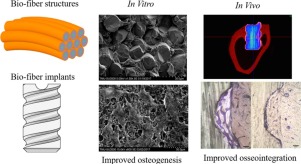Dental Materials ( IF 4.6 ) Pub Date : 2017-12-26 , DOI: 10.1016/j.dental.2017.12.001 Ya-Hui Chan , Wei-Zhen Lew , Emily Lu , Thomas Loretz , Luke Lu , Che-Tong Lin , Sheng-Wei Feng

|
Objectives
The aim of this study was to evaluate the in vitro biocompatibility and in vivo osseointegration of three novel bioactive glass fiber reinforced composite (GFRC) implants and to compare these with metal (Ti6Al4V) implants.
Methods
The surfaces of these experimental substrates were characterized by scanning electron microscopy (SEM), a 2D profilometer and by contact angle measurement. In vitro biological performance was assessed using MG-63 human osteoblast-like cell morphology, cell proliferation assays and the alkaline phosphatase (ALP) activity testing. Furthermore, in vivo osseointegration performance was examined by installing samples into rabbit femurs and evaluated the results using micro-CT, histology and histomorphometrical analysis; these assessments were carried out after 1, 2, 4 and 8 weeks of healing.
Results
The results showed that moderate surface roughness, moderate hydrophilic exposure and moderate homogenous exposure of bioactive glass fibers were present for all of the GFRC substrates. Furthermore, MG-63 cells, when cultured on all of the GFRC substrates, grew well and exhibited a more differentiated phenotype than cells grown on titanium alloy (Ti6Al4V) substrate. Histological evaluation revealed more newly-formed bone regeneration within the thread of the GFRC implants during the initial healing period. In addition, the novel GFRC implants with a bioactive Bio-fiber structure and glass particles within the epoxy resin matrix showed better bone volume/tissue volume (BV/TV) values at 4 weeks and this was accompanied by bone-implant contact (BIC) values at 8 weeks comparable to the Ti6Al4V group.
Significance
These findings demonstrated that novel GFRC implants seem to show improved osteogenesis and osseointegration functionality and have potential as a substitute for Ti6Al4V, or other metal-based materials, when used for clinically dental and orthopedic applications.
中文翻译:

新型玻璃纤维增强复合材料植入物的生物相容性和骨整合的评估:体外和体内研究
目标
这项研究的目的是评估三种新型生物活性玻璃纤维增强复合材料(GFRC)植入物的体外生物相容性和体内骨整合,并将其与金属(Ti6Al4V)植入物进行比较。
方法
这些实验基材的表面通过扫描电子显微镜(SEM),2D轮廓仪和接触角测量进行表征。使用MG-63人成骨细胞样细胞形态,细胞增殖测定法和碱性磷酸酶(ALP)活性测试评估了体外生物学性能。此外,通过将样品安装到兔股骨中检查体内骨整合性能,并使用微CT,组织学和组织形态计量学分析评估结果;这些评估是在愈合1、2、4和8周后进行的。
结果
结果表明,所有GFRC基材均存在适度的表面粗糙度,适度的亲水性暴露和适度的生物活性玻璃纤维均质暴露。此外,当在所有GFRC基质上培养时,MG-63细胞生长良好,并且表现出比在钛合金(Ti6Al4V)基质上生长的细胞更高的分化表型。组织学评估显示,在初始愈合期间,GFRC植入物的螺纹内有更多新形成的骨再生。此外,具有生物活性生物纤维结构和环氧树脂基质内玻璃颗粒的新型GFRC植入物在4周时显示出更好的骨体积/组织体积(BV / TV)值,并伴有骨-植入物接触(BIC)在8周时的值与Ti6Al4V组相当。
意义
这些发现表明,新颖的GFRC植入物似乎具有更好的成骨性和骨整合功能,并且在临床上用于牙科和整形外科领域时,具有替代Ti6Al4V或其他金属基材料的潜力。










































 京公网安备 11010802027423号
京公网安备 11010802027423号